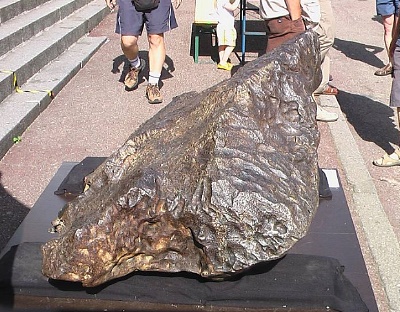IMCA Insights – November 2009
The World's Largest Meteorites
by Norbert Classen
The largest meteorites found are usually irons. This is due to the fact that iron meteorites are more stable compared to stony or stony-iron meteorites. The latter two types of meteorites often break up into many pieces upon entering the atmosphere, creating the most impressive phenomenon known as a meteorite shower. Moreover, they suffer from the effects of ablation much more than irons during their passage through the atmosphere. Finally, large iron blocks seem to be much more resistant to the severe effects of terrestrial weathering.
With an estimated mass of over 60 tons the Hoba iron is by far the largest known meteorite (as a single piece). It was found on a farm near Grootfontein in the Otjozondjupa Region of Namibia in the early 20th century, and it still resides at its find location today. It has been declared a National Monument by the Government of Southwest Africa (now Namibia) in 1955.
The 60 ton plus Hoba
iron meteorite at its find location in Namibia
(Photo © Gábor Ámon)
The following list shows the top twelve of the largest iron meteorites - the real giants over 10 tons. Please note that this list doesn't display the total known weight of each distinct fall, but rather the weights of the largest individuals that have been recovered from each fall.
Iron Meteorite Charts
| Meteorite | Find | Class | Weight° |
| Hoba | Namibia, 1920 | IVB | 60.00 |
|
Campo del Cielo (El Chaco) |
Argentina, 1969 | IAB | 37.00 |
| Cape York (Ahnighito) | Greenland, 1894 | IIIAB | 30.87 |
| Armanty | China, 1898 | IIIE | 28.00 |
| Bacubirito | Mexico, 1863 | UNG | 22.00 |
| Cape York (Agpalilik) | Greenland, 1963 | IIIAB | 20.10 |
| Mbosi | Tanzania, 1930 | UNG | 16.00 |
| Campo del Cielo | Argentina, 2005 | IIIAB | 14.85 |
| Willamette | USA, 1902 | IIIAB | 14.14 |
| Chupaderos I | Mexico, 1852 | IIIAB | 14.11 |
| Mundrabilla I | Australia, 1966 | IAB | 12.40 |
| Morito | Mexico, 1600 | IIIAB | 10.10 |
| ° weight estimates given in metric tons | |||
The largest known stony-iron meteorite is a relatively new Russian find from 2007, a huge 2.7 ton individual of the Seymchan pallasite. I had the pleasure to see this mass at the Ste. Marie aux Mines Mineral Show, Alsace, France, in 2008 - a real sight to behold.
The 2.7 ton Main Mass
of Seymchan at the Ste. Marie Show 2008
(Photo © Hanno Strufe)
The following list shows the top six of the largest stony-iron meteorites, all pallasites. Please note once more that this list doesn't display the total known weight of each distinct fall, but rather the weights of the largest individuals that have been recovered from each fall.
Stony-Iron Meteorite Charts
| Meteorite | Find | Class | Weight° |
| Seymchan | Russia, 2007 | Pallasite | 2.70 |
| Huckitta | Australia, 1937 | Pallasite | 1.41 |
| Fukang | China, 2000 | Pallasite | 1.00 |
| Esquel | Argentina, 1951 | Pallasite | 0.75 |
| Krasnojarsk | Russia, 1749 | Pallasite | 0.70 |
| Brenham | USA, 2005 | Pallasite | 0.65 |
| ° weight estimates given in metric tons | |||
The final list below shows the top five of the largest stony meteorites, all but one ordinary chondrites and all representing witnessed falls. Please note again that this list doesn't display the total known weight of each distinct fall, but rather the weights of the largest individuals that have been recovered from each fall.
Stony Meteorite Charts
| Meteorite | Fell | Class | Weight° |
| Jilin | China, 1976 | H5 Chondrite | 1.77 |
| Norton County | USA, 1948 | Aubrite | 1.07 |
| Long Island* | USA, 1891 | L6 Chondrite | 0.56 |
| Paragould | USA, 1930 | LL5 Chondrite | 0.37 |
| Bjurböle* | Finland, 1899 | L/LL4 Chondrite | 0.33 |
|
° weight estimates given in
metric tons * these are broken individuals - not preserved |
|||
For
further reference, much more information, and some great photos of the
individual masses of the largest iron meteorites, see a more detailed
list of the largest meteorites,
compiled by IMCA Member Mike Jensen.
•
IMCA Home Page •
IMCA Code of Ethics •
IMCA Member List
•
Join IMCA •
IMCA Meteorite Info
